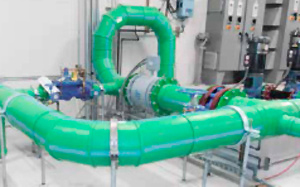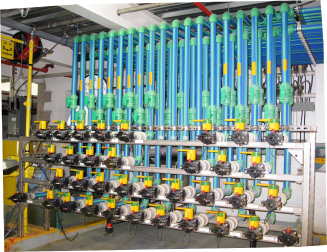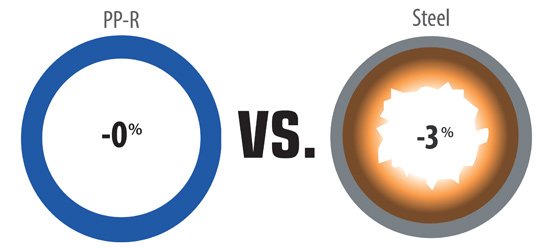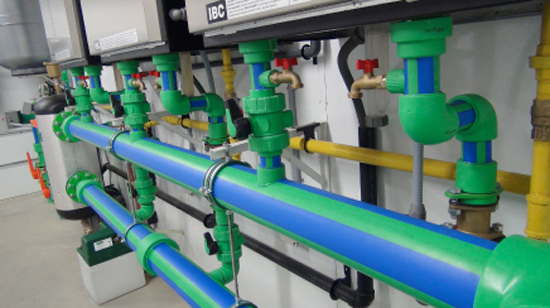Polypropylene-Random (PP-R) Piping Systems Serve Multiple Applications
Potable Water Green Piping
Since it is free of heavy metals and toxic chemicals, one manufacturer's PP-R pipe has been tested and listed for compliance with ASTM F2389, NSF 61 and NSF 372, providing a safe option for potable water systems required for drinking water. For food processing, listing to NSF 51 is required. Unlike other piping materials that may allow trace amounts of chemicals to be pulled from the pipe walls or joints into the water, hydrophobic polypropylene green pipe prevents leaching.

Photo courtesy of Aquatherm
An Alaskan correctional facility used PP-R piping in sizes ranging from ½-in. to 12-in.-dia for: potable, water treatment, wastewater, hydronic and compressed air systems.
One leading manufacturer has developed resin that is 97 percent pure polypropylene-random, with less than 3 percent additives. The additives include green pigmentation for opacity to prevent microbiological growth, ion deactivators (to protect the PP-R from free metal ions) and heat stabilizers. Heat stabilizers protect the PP-R from short-term exposure to high temperatures (200+°F) in the event of equipment malfunction as well as long-term exposure to rated elevated temperatures. This particular pipe product can also be used for multipurpose residential sprinkler applications (per NFPA 13D) and is available with UV protection for outdoor installations and multilayer faser technology, which reduces linear expansion. The manufacturer offers over 400 fittings, transitions and valves, for installation in a variety of systems.
One manufacturer's PP-R green pipe is code approved for potable water (NSF 61) and direct food contact and food processing up to 212°F (NSF 51), IPC, UPC, NFPA, FM and is in accordance with CSA B137.11.
While it could be used for virtually all of the systems being discussed, green PP-R pipe is best suited for the following applications for which it is designed:
Potable water. Approved for direct contact with food and potable water and can be used as the distribution main system in hospitals, schools, high-rise buildings, hotels, shipbuilding, sports facilities, residences and many other projects.
Compressed air systems. With a thicker-walled SDR (e.g., 7.4) green pipe PP-R can offer superior pressure ratings and resistance to shattering. Additionally, because PP-R piping systems do not corrode, attached equipment is protected from rust and debris.
Multipurpose fire sprinklers (NFPA 13D). For one- and two-family dwelling occupancies, green pipe can be integrated with the potable water system to provide fire protection. The high flow rates allow for mains and branches to be run through the building rather than through many individual pipes, keeping the system simple and efficient.
Marine applications. Because green pipe is made from hydrophobic, low-friction material it is unaffected by the dissolved minerals contained in seawater, freshwater and brine.

Photo courtesy of Aquatherm
At a Midwestern paper mill, more than 19,000 ft of PP-R pipe, connected by roughly 4,250 fittings and valves, provided a single-material solution.
Medium-Thick Blue Piping for Hydronics and Industrial Applications
For applications that do not require potable ratings, blue PP-R piping is engineered with heat stabilization and can serve as a tougher, longer-lasting alternative to steel, stainless steel and some plastics for heating, cooling and industrial applications. It offers higher volumetric flow rates due to thinner walls, and with MF, the same improvement in thermal expansion compared to non-reinforced plastics. While other piping materials lose performance over time to scaling and corrosion, this engineered PP-R material can resist any form of change to the material wall, and is resistant to impact and seismic stresses.

Image courtesy of Aquatherm
Corrosion and scaling can reduce the inside of steel pipes by an average of 3 percent per year.
Even after decades of use, PP-R pipe has been found to retain its original flow characteristics. This prevents the loss of efficiency that occurs from scaling and corrosion when using a pipe that can scale or corrode and will save energy over the life of the system. Corrosion and scaling can reduce the inside of steel pipes by an average of 3 percent per year, resulting in lost efficiency and up to 10 percent increased pumping energy annually. This can add up to thousands of dollars in hidden energy costs over the life of the system.

Photo courtesy of Aquatherm
High-capacity manifold systems using engineered PP-R with multilayer faser technology can be used for heating distribution.









